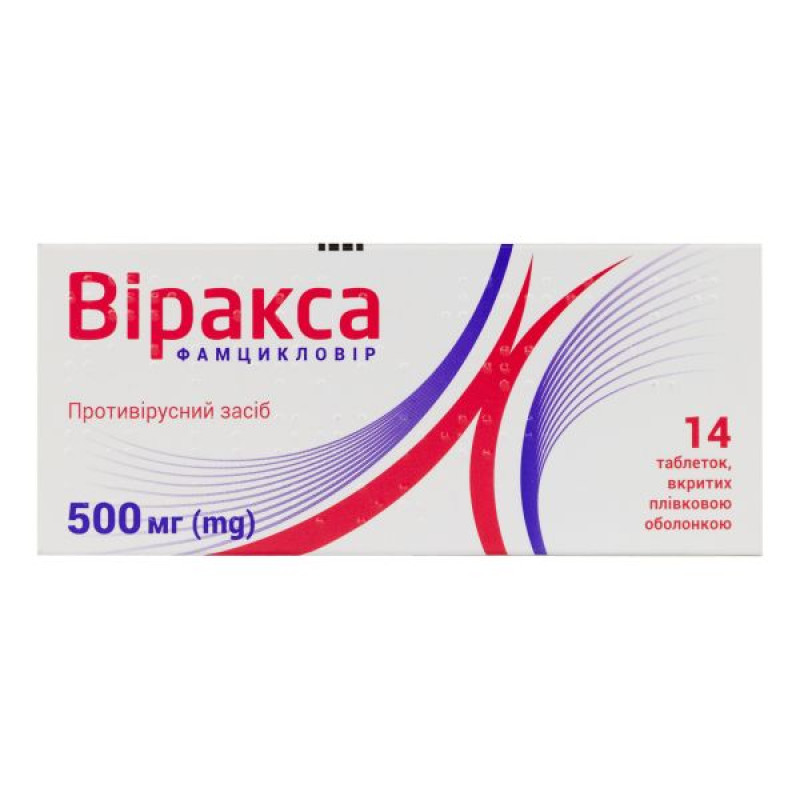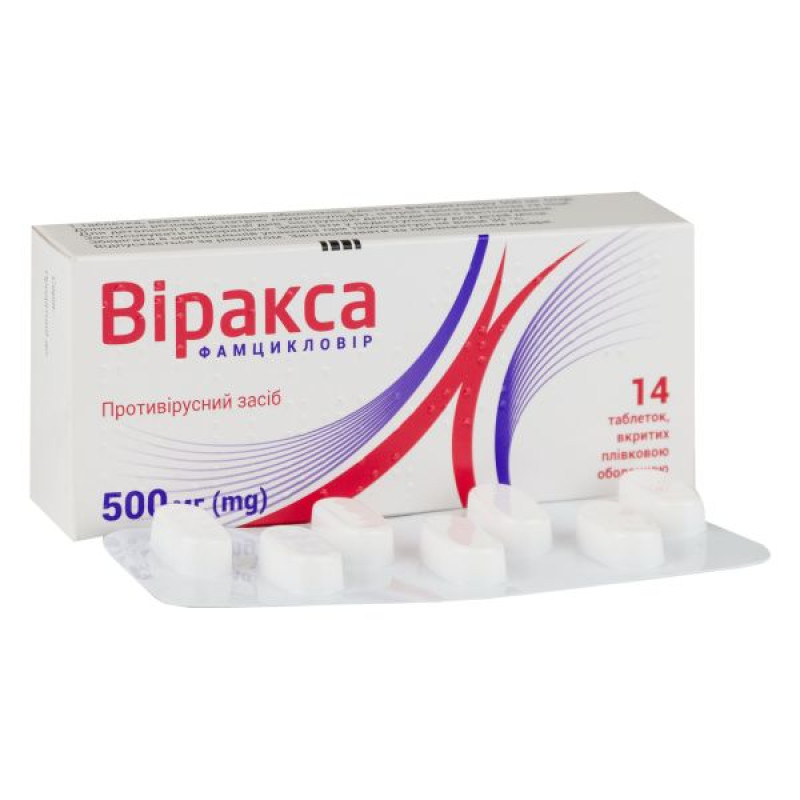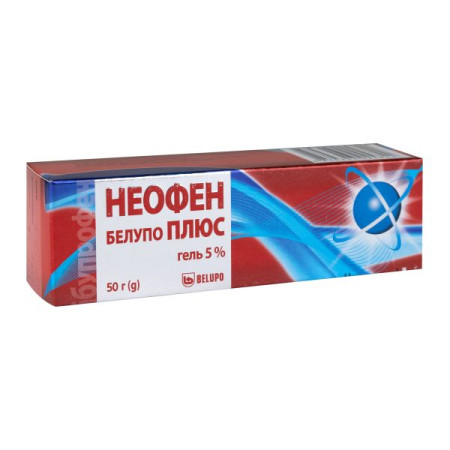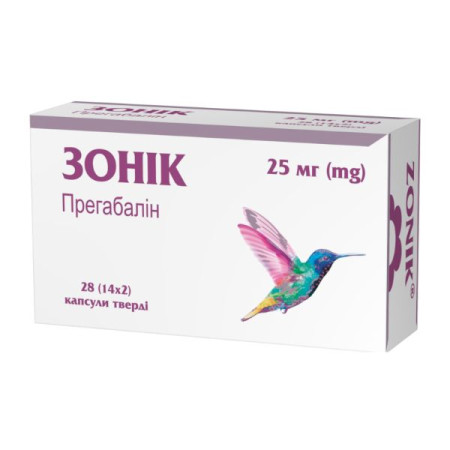Virax tablets 500mg No. 14
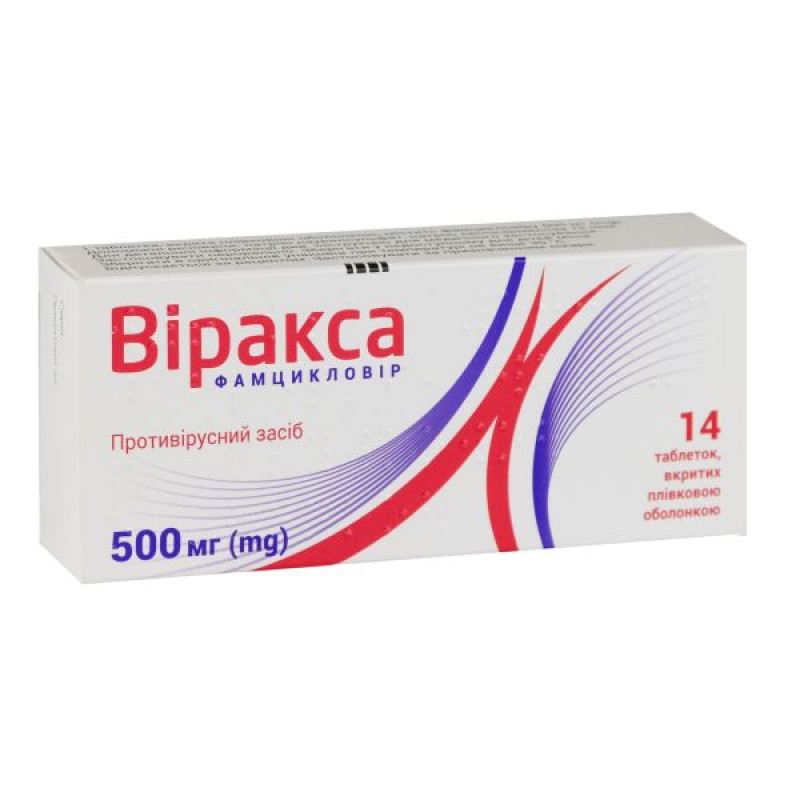
Instructions for Virax tablets 500mg No. 14
Composition
active ingredient: famciclovir;
1 tablet contains famciclovir 125 mg or 250 mg or 500 mg;
excipients: pregelatinized starch, sodium lauryl sulfate, microcrystalline cellulose, croscarmellose sodium, colloidal anhydrous silica, stearic acid, Opadry white OY-S-28924 (hypromellose (5 CP), titanium dioxide (E171), hypromellose (15 CP), macrogol 4000, macrogol 6000).
Dosage form
Film-coated tablets.
Main physicochemical properties:
125 mg tablets: white, film-coated, round, biconvex, with beveled edges;
250 mg tablets: white, film-coated, round, biconvex, with a score on one side, with beveled edges;
500 mg tablets: white, film-coated, oval, biconvex, with a score on both sides.
Pharmacotherapeutic group
Direct-acting antivirals. Nucleosides and nucleotides, except reverse transcriptase inhibitors. Famciclovir.
ATX code J05A B09.
Pharmacological properties
Pharmacodynamics.
When administered orally, famciclovir is rapidly converted to penciclovir, which is active against Herpes simplex viruses types 1 and 2 and Varicella zoster, as well as Epstein-Barr virus and cytomegalovirus.
Penciclovir enters virus-infected cells, where it is rapidly converted to monophosphate by viral thymidine kinase, which in turn is converted to triphosphate by cellular enzymes. Penciclovir triphosphate remains in virus-infected cells for more than 12 hours, inhibiting the synthesis of viral DNA (deoxyribonucleic acid) and virus replication in them. The half-life of penciclovir triphosphate in cells infected with Varicella zoster, Herpes simplex type 1 and 2 viruses is 9, 10 and 20 hours, respectively. The concentration of penciclovir triphosphate in uninfected cells does not exceed the minimum required, so in therapeutic concentrations penciclovir does not affect uninfected cells. The probability of its toxic effect is too low, and uninfected cells are unlikely to be damaged by therapeutic concentrations of penciclovir.
Penciclovir is active against recently identified acyclovir-resistant strains of Herpes simplex virus with altered DNA polymerase.
The incidence of resistance to famciclovir (penciclovir) does not exceed 0.3% in patients with normal immunity and 0.19% in patients with impaired immunity. Resistance was detected only at the beginning of treatment and did not develop during treatment or after the end of therapy.
In patients with herpes zoster, the severity and duration of postherpetic neuralgia is significantly reduced.
In patients with compromised immunity due to human immunodeficiency virus (HIV) infection, famciclovir at a dose of 500 mg twice daily reduces the number of days of shedding of the Herpes simplex virus (both with and without clinical manifestations).
Pharmacokinetics.
When administered orally, famciclovir is rapidly and efficiently absorbed and converted to the active antiviral compound penciclovir.
Penciclovir bioavailability is 77%. The increase in penciclovir plasma concentrations occurs in parallel with an increase in a single dose of famciclovir in the range of 125 - 1000 mg. The maximum concentration (Cmax) of penciclovir after oral administration of 125 mg, 250 mg or 500 mg of famciclovir is achieved on average after 45 minutes and is 0.8 μg/ml, 1.6 μg/ml and 3.3 μg/ml, respectively. In other studies, the Cmax of penciclovir after oral administration of 250 mg, 500 mg or 1000 mg of famciclovir was 1.5 μg/ml, 3.2 μg/ml and 5.8 μg/ml, respectively.
The systemic bioavailability [area under the concentration-time curve (AUC)] of penciclovir is independent of the time of ingestion. The AUC of penciclovir with a single dose of famciclovir and with the division of the daily dose of famciclovir into 2 or 3 doses are similar, indicating the absence of cumulation of penciclovir with repeated administration of famciclovir.
The plasma protein binding of penciclovir and its 6-deoxy precursor is less than 20%.
Famciclovir is excreted primarily as penciclovir and its 6-deoxy-precursor, which are excreted unchanged in the urine. Famciclovir is not detected in the urine. The terminal half-life of penciclovir from plasma after single and multiple doses of famciclovir is approximately 2 hours.
Pharmacokinetics in special cases
In patients with Varicella zoster infection, no significant changes in the pharmacokinetic parameters of penciclovir were observed. The terminal half-life of penciclovir after single and multiple doses of famciclovir was 2.8 and 2.7 hours, respectively.
Patients with renal insufficiency
In patients with renal insufficiency, after single and multiple doses of famciclovir, a linear relationship was observed between the decrease in plasma clearance, renal clearance, the rate of elimination of penciclovir from blood plasma, and the severity of renal insufficiency. The pharmacokinetic features of famciclovir in patients with severe (decompensated) renal impairment have not been studied.
In patients with mild to moderate hepatic impairment, AUC is not altered. The pharmacokinetics of penciclovir in patients with severe hepatic impairment have not been studied. It cannot be ruled out that the conversion of famciclovir to the active metabolite penciclovir may be impaired in this group of patients, which may result in decreased plasma concentrations of penciclovir and, as a result, reduced efficacy of famciclovir.
Elderly patients (over 65 years of age)
In patients aged 65–70 years, an increase in mean penciclovir AUC of approximately 40% and a decrease in penciclovir renal clearance of approximately 20% were observed compared to patients under 65 years of age, which may be due in part to age-related changes in renal function in patients over 65 years of age.
The patient's gender does not affect the pharmacokinetic parameters of famciclovir (slight differences in penciclovir clearance in men and women).
When using famciclovir (single or multiple doses of 500 mg 1, 2 or 3 times a day) in healthy black volunteers and black patients with impaired renal or hepatic function, no differences in pharmacokinetic parameters were found compared to the use of famciclovir in similar groups of Caucasian patients.
Indication
Varicella virus (VZV), infections – herpes zoster:
‒ Treatment of herpes and ophthalmic lichen for immunocompetent adults
‒ Treatment of herpes in immunocompromised adults
Herpes simplex virus (HSV), infections – genital herpes:
‒ Treatment of the first manifestations and recurrences of genital herpes in immunocompetent patients;
- Treatment of recurrent genital herpes in immunocompromised adults;
- Suppression of recurrent genital herpes in immunocompetent patients and in immunocompromised patients.
Contraindication
Known hypersensitivity to famciclovir or to any of the other components of the drug, as well as hypersensitivity to penciclovir.
Interaction with other drugs and other types of interactions
Effects of other drugs on famciclovir
Probenecid and other drugs that affect renal physiology may alter the plasma levels of penciclovir (the active metabolite of famciclovir).
There were no clinically significant changes in the pharmacokinetics of penciclovir following administration of a single 500 mg dose of famciclovir following pre-treatment with multiple doses of allopurinol, cimetidine, theophylline, zidovudine or promethazine, or following administration shortly after administration of antacids (magnesium hydroxide and aluminium hydroxide), or concomitant administration with emtricitabine. No clinically significant effect on the pharmacokinetics of penciclovir was observed following multiple (3 times daily) administration of famciclovir (500 mg) with multiple doses of digoxin.
The conversion of the inactive metabolite 6-deoxypenciclovir to penciclovir is catalyzed by aldehyde oxidase. There is a potential for interactions with other drugs that are metabolized and/or inhibited by this enzyme. In vitro clinical studies of the interaction of famciclovir with cimetidine and promethazine, inhibitors of aldehyde oxidase, did not show a significant effect on the formation of penciclovir. However, raloxifene, a more potent inhibitor of aldehyde oxidase, may affect the formation of penciclovir.
Effect of famciclovir on other medicinal products
The pharmacokinetics of digoxin were not altered by co-administration of single or multiple (3 times daily) doses of famciclovir (500 mg). There was no clinically significant effect on the pharmacokinetics of zidovudine, its metabolites (zidovudine glucuronide) or emtricitabine following co-administration of a single 500 mg oral dose of famciclovir with zidovudine or emtricitabine.
Although famciclovir is only a weak inhibitor of aldehyde oxidase in vitro, interactions with drugs metabolized by aldehyde oxidase may potentially occur. Studies have not shown the potential for cytochrome P450 induction or CYP3A4 inhibition.
Application features
The drug should be used with caution in patients with renal failure and severe (decompensated) liver dysfunction (no experience of use).
Patients with renal insufficiency
Particular attention should be paid to patients with impaired renal function, who require dosage adjustment (see sections “Method of administration and dosage” and “Overdose”).
Patients with hepatic insufficiency
Famciclovir has not been studied in patients with severe hepatic impairment. The conversion of famciclovir to its active metabolite penciclovir may be impaired in such patients, which may result in decreased plasma concentrations of penciclovir and, as a result, reduced efficacy of famciclovir.
Use in the treatment of herpes zoster
Patients with complicated herpes zoster, such as those with internal organ involvement, disseminated herpes zoster, motor neuropathy, encephalitis, and cerebrovascular complications, should receive intravenous antiviral therapy.
Also, immunocompromised patients with ocular herpes zoster or patients at high risk of spreading the disease and affecting internal organs should receive intravenous antiviral therapy.
Transmission of genital herpes
Genital herpes is a sexually transmitted disease. The risk of transmission increases during the acute phase of the disease. Patients should be advised to avoid sexual intercourse if they are symptomatic, even if antiviral therapy has already been initiated. During suppressive therapy with antiviral agents, the frequency of viral shedding is significantly reduced. However, the risk of transmission remains, so patients should use appropriate contraceptive measures.
Use during pregnancy or breastfeeding
Pregnancy
Experimental studies have not revealed any embryotoxic or teratogenic effects of famciclovir and penciclovir.
During studies of internal use of famciclovir, penciclovir was noted to be excreted in breast milk. It is not known whether penciclovir is excreted in breast milk. The safety of famciclovir in pregnant and lactating women has not been established. The drug should be prescribed during pregnancy or lactation only if the benefit of therapy for the mother outweighs the potential risk to the fetus or child.
Breastfeeding period
It is not known whether famciclovir is excreted in human milk. Animal studies have shown that penciclovir is excreted in human milk. If the condition of the woman requires the administration of famciclovir, the question of discontinuing breastfeeding should be considered.
Fertility
The effect of famciclovir on male fertility after long-term oral administration of the drug at a dose of 250 mg 2 times a day has not been detected.
Ability to influence reaction speed when driving vehicles or other mechanisms
There are no data on the impairment of patients' ability to drive or operate machinery under the influence of Virax. However, patients who experience dizziness, drowsiness, confusion, or other central nervous system disorders while taking Virax should refrain from driving or operating machinery.
Method of administration and doses
Since the systemic bioavailability of penciclovir was not altered when famciclovir was taken with food, famciclovir can be administered without regard to meals.
Shingles in immunocompetent patients
500 mg 3 times a day for 7 days. Treatment gives better results if it is started immediately after the appearance of the rash.
Shingles in immunocompromised patients
500 mg 3 times a day for 10 days. It is recommended to start treatment immediately after the appearance of rashes.
Genital herpes in immunocompetent patients
The first manifestation of genital herpes
250 mg 3 times a day for 5 days. It is recommended to start treatment immediately after the appearance of genital herpes.
Recurrence of genital herpes
125 mg 2 times a day for 5 days. It is recommended to start treatment in the prodromal period (tingling sensation, itching, burning, pain) or immediately after the appearance of genital herpes.
Recurrence of genital herpes in immunocompromised patients
500 mg 2 times a day for 7 days. It is recommended to start treatment in the prodromal period (tingling sensation, itching, burning, pain) or immediately after the appearance of rashes.
Suppression of recurrent genital herpes in immunocompetent patients
250 mg twice daily. The duration of treatment depends on the severity of the disease, but treatment should be discontinued after 12 months of continuous therapy in order to reassess the severity of relapses and their frequency. The minimum reassessment period should include two relapses. A dose of 500 mg twice daily has been shown to be effective in immunocompromised patients.
Suppression of recurrent genital herpes in immunocompromised patients
500 mg 2 times a day.
Dosage for patients with impaired renal function
Since decreased clearance of penciclovir is associated with impaired renal function, consistent with changes in creatinine clearance, special attention should be paid to dosing in patients with impaired renal function.
The following dosage regimen is recommended:
Herpes zoster in immunocompetent adult patients and immunocompromised patients
Creatinine clearance (ml/min/1.73 m2) | Dosage |
| ³ 60 | 500 mg 3 times a day for 7 or 10 days* |
| From 40 to 59 | 500 mg twice daily for 7 or 10 days* |
| From 20 to 39 | 500 mg once daily for 7 or 10 days* |
| < 20 | 250 mg once daily for 7 or 10 days* |
| Patients on dialysis | 250 mg after each dialysis for 7 or 10 days* |
First manifestation of genital herpes in immunocompetent adult patients
Creatinine clearance (ml/min/1.73 m2) | Dosage |
| ³ 40 | 250 mg 3 times a day for 5 days |
| From 20 to 39 | 250 mg 2 times a day for 5 days |
| < 20 | 250 mg once daily for 5 days |
| Patients on dialysis | 250 mg after each dialysis for 5 days |
Recurrence of genital herpes in immunocompetent adult patients
Creatinine clearance (ml/min/1.73 m2) | Dosage |
| ³ 20 | 125 mg 2 times a day for 5 days |
| < 20 | 125 mg once daily for 5 days |
| Patients on dialysis | 125 mg after each dialysis for 5 days |
Recurrence of genital herpes in immunocompromised adult patients
Creatinine clearance (ml/min/1.73 m2) | Dosage |
| ³ 40 | 500 mg 2 times a day for 7 days |
| From 20 to 39 | 500 mg once daily for 7 days |
| < 20 | 250 mg once daily for 7 days |
| Patients on dialysis | 250 mg after each dialysis for 7 days |
Suppression of recurrent genital herpes in immunocompetent adult patients
Creatinine clearance (ml/min/1.73 m2) | Dosage |
| ³ 40 | 250 mg 2 times a day |
| From 20 to 39 | 125 mg 2 times a day |
| < 20 | 125 mg once daily |
| Patients on dialysis | 125 mg after each dialysis |
Suppression of recurrent genital herpes in immunocompromised adult patients
Creatinine clearance (ml/min/1.73 m2) | Dosage |
| ³ 40 | 500 mg 2 times a day |
| From 20 to 39 | 500 mg 2 times a day |
| < 20 | 250 mg once daily |
| Patients on dialysis | 250 mg after each dialysis |
Patients with impaired renal function who are on hemodialysis
A 4-hour hemodialysis session reduces plasma penciclovir concentrations by approximately 75%; the famciclovir dose should be administered immediately after dialysis. The dosing regimen for patients on dialysis is included in the tables.
Patients with impaired liver function
No dosage adjustment is required for patients with hepatic impairment. There are no data available for patients with severe hepatic impairment.
Elderly patients (≥ 65 years)
Dosage adjustment is not required if there are no renal impairment.
Maximum tolerated daily dose and duration of treatment
Normal sensitivity was observed in patients with herpes zoster who received 750 mg 3 times a day for 7 days. Similar sensitivity was observed in patients with genital herpes who received up to 750 mg 3 times a day for 5 days and up to 500 mg 3 times a day for 10 days. Normal tolerability was observed in studies in which patients with genital herpes received a dose of 250 mg 3 times a day.
A similar response was observed in immunocompromised patients with herpes zoster who received up to 500 mg 3 times daily for 10 days and in immunocompromised patients with herpes simplex who received up to 500 mg 2 times daily for 7 days and 500 mg 2 times daily for 8 weeks.
Children.
The efficacy and safety of famciclovir in children have not been studied. Therefore, the drug is not used in patients of this age group.
Overdose
Data on overdose of famciclovir are limited. Reports of accidental acute overdoses (10.5 g) are limited. Long-term use (10 g per day for 2 years) of famciclovir did not cause complications. In case of overdose, supportive therapy should be used. Isolated cases of acute renal failure have been described in patients with a history of kidney disease in whom the dose of Virax was not reduced accordingly. The concentration of the drug is reduced by approximately 75% during 4 hours of hemodialysis.
Adverse reactions
From the blood system: thrombocytopenia.
Mental: confusion (mainly in elderly patients), hallucinations.
From the side of the central nervous system: headache, dizziness, drowsiness (mainly in elderly patients).
Gastrointestinal: nausea, vomiting.
On the part of the hepatobiliary system: altered liver function tests, cholestatic jaundice.
Skin and subcutaneous tissue disorders: rash, pruritus, angioedema, facial edema, eyelid edema, periorbital edema, laryngeal edema, urticaria, severe allergic reactions (e.g. erythema multiforme, Stevens-Johnson syndrome, toxic epidermal necrolysis), leukocytoclastic vasculitis.
Musculoskeletal system: myalgia, arthralgia.
From the urinary system: hypercalcemia, changes in creatinine clearance, hemolytic-uremic syndrome (when using high doses of famciclovir in patients with reduced immunity).
Others: increased sweating, fever.
Expiration date
2 years.
Storage conditions
Store in the original packaging at a temperature not exceeding 30 ºС.
Keep out of reach of children.
Packaging
For dosage 125 mg: 10 tablets in a blister; 1 blister in a cardboard pack.
For 250 mg dosage: 7 tablets in a blister; 3 blisters in a cardboard pack.
For 500 mg dosage: 7 tablets in a blister; 2 or 3 blisters in a cardboard pack.
Vacation category
According to the recipe.
Producer
SPECIFAR SA
Location of the manufacturer and address of its place of business
1, 28 Oktovriou str, Agia Varvara, 12351, Greece
There are no reviews for this product.
There are no reviews for this product, be the first to leave your review.
No questions about this product, be the first and ask your question.







